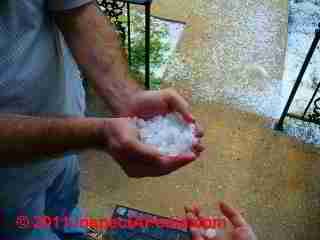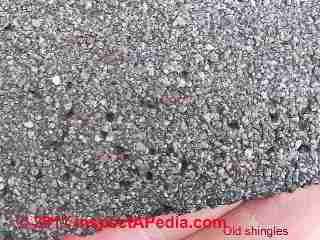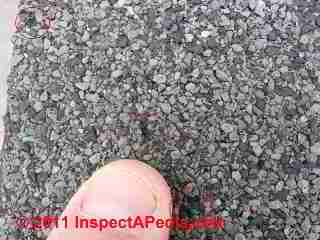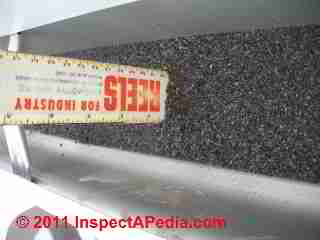 Asphalt Roof Shingle Storm or Hail Damage Testing & Simulation
Asphalt Roof Shingle Storm or Hail Damage Testing & Simulation
Homeowner tries to simulate hail damage to shingles
- POST a QUESTION or COMMENT about Roof Shingle Hail Damage & how Hail Damage is Distinguished from Blistering, Foot Traffic, or Other Roof Wear, & about Roof Inspection Procedures
Hail damage testing on asphalt roof shingles:
Is it possible to confirm actual hail damage to roof shingles by comparing them with simulated weather conditions applied to a sample of new product of the same shingle brand? This resourceful homeowner gave it a try, with interesting results.
InspectAPedia tolerates no conflicts of interest. We have no relationship with advertisers, products, or services discussed at this website.
Home "Oven Test" Attempts to Replicate Roof Shingle Damage from Hail

B.L. continues our hail damage and roof blister discussion with a do-it-yourself home test of roof shingles and more photographs of shingle granule loss.
Are you saying that the photos look like blistering?
I did some testing over the weekend. I took brand new shingles and some from my unaffected front roof. I mounted them to a piece of roof sheathing, added felt paper, and overlapped the shingles as they would be installed in the field.
I then tried to simulate the weather they were exposed to before the hailstorm. First I put the assemblies in the oven and heated them to 100F (checked with a calibrated laser sensor) to simulate the roof temperature with an outdoor ambient air temperature of 70F.
[Photo below left: closeup of shingle condition on the roof following a hail storm. Photo below right, closeup of shingle mineral granule loss after B.L.'s home oven test.]

Watch out: readers should keep in mind that cooking potentially combustible materials in a home oven is a potential fire hazard.
I next set the assemblies outside for 45 minutes in the 50F air temperature to simulate the temperature drop before the hailstorm. The temperature of the shingles dropped to around 65F. I next sprayed the assemblies with cold water from the hose to simulate the ice cold rain. The shingle temperatures dropped to around 45F. I next threw 1" diameter ice cubes at the assemblies and then washed them down with another spray of water from the hose.
Interestingly, the ice impacts did not imbed granules into the asphalt. Some granules broke away from the surface of the shingles taking the asphalt with them. These small spots revealed the fiberglass mat.
My assumption is that the coldness of the rain and ambient air temperature made the asphalt hard and brittle versus soft and pliable. When the hail hit the roof it separated the hard asphalt from the fiberglass. Then the stones just washed away with the asphalt still intact.
I have attached photographs of the test results [see above]. I think the damage looks the same on both old and new shingles (but it is more severe on the old shingles that were about half way through their service life). Unfortunately I could not simulate hundreds of hits in the same area for about a half an hour.
My test had very few impacts because it was limited to the amount of ice I had available. I think if I could have hit some of the same areas that lost the stones already, I think I would have been able to replicate the hail damage sustained to my roof on March 29, 2009.
Your thoughts?
Reply: The Account Supports Hail Damage, But Asphalt Shingle Blisters, Even Hard-to-See Blisters may Increase Shingle Hail Damage Vulnerability
No, I'm not saying that the primary cause of your roof shingle granule loss is due to blistering alone. Your account of the before and after roof inspection and description of the damage (no visible granule loss before storm, lots of granules lost after storm) very strongly supports your claim of hail damage.
Here we are discussing the role that pre-existing and not easily-visible roof blisters might play in hail damage on a roof.
However I reported that one of your photos shows what appears to be slight blistering and one or more blisters that have only slight opening or top punctures.
Therefore I pose that there may be some blisters on shingles that were not obvious to you - you can check best using oblique lighting as I said earlier.
Nevertheless, your account points to hail damage. The relationship of hail damage to blisters is, in my opinion, derived from the premise that if an asphalt roof has shingle blistering, just as I've said elsewhere that foot traffic can damage those areas, so might hail damage cause additional damage by puncturing and opening the tops of blisters earlier than would have otherwise happened due to normal aging.
The theory of relationship between preexisting blisters on a roof (possibly not showing as open craters or pits) and hail damage is based on an important observation: that the raised "bumps" are true blisters - that is that they are true raised blisters, with some hollow core and a top blister shell (to be burst by foot traffic, hail, or other mechanical damage).
In contrast, apparent blistering or blister rash on shingles is comprised of similar looking bumps, but each raised area is comprised of solid material (asphalt and mineral granules, for example), those bumps may be less vulnerable to converting to open craters or pits due to mechanical wear.
About the Do-it-Yourself Roof Shingle Test for Hail Damage
I am not sure that a professional shingle test lab would necessarily like your home oven test, as there are ASTM and other roof shingle testing standards, but I agree that your photographs of your oven-tested roof shingles and the on-roof shingle damage look similar.
Certainly your home test was likely to be less stressful on the shingle granule coating than an actual hail storm that would impact the shingles repeatedly over a longer period and more uniformly over roof surfaces (depending on storm duration, wind direction, hailstone size, and the hailstone terminal velocity etc.) than your test.
You did not report the role that aging and repeated thermal heating cooling cycles have on roof shingles, nor the size nor terminal velocity of the ice you shot at your roof shingles.
CONTACT us to suggest technical corrections, additions, or references on hail damage and blister damage to roofing.
To return to the roof blister damage versus hail damage question and summarize:
- Regardless of whether or not there are blisters or blister rash on your roof shingles, if there were pre-existing blisters that were not opened, if there were no visible pits or craters or areas of exposed shingle substrate prior to the hail storm and no significant volume of mineral granules appearing in your roof gutters or on the ground at the ends of downspout leaders before the storm, and if those conditions were in fact observed after the storm, that is a compelling argument for asserting that the damage was caused by the hailstorm.
- A rebutting argument that is plausible is that sometimes people do not notice a pre-existing condition until events make them take a closer look, thus confusing old with new conditions. The assessment of this argument turns on the timing and confidence in earlier observations made of or on a roof.
- You should inspect the roof for the extent of blistering in order to determine if that condition may have been a factor in the extent of damage caused by subsequent hail damage. Using an oblique light when the roof is not in direct bright sunlight should be helpful, as you can see in some of our other photos of roof shingle blister rash.
- Watch out: Indeed foot traffic on roofs, especially in hot weather or on old brittle roof shingles can cause extensive damage. Often we can see on an older roof just where the "inspector" walked by the foot traffic damage, and often we see foot traffic damage concentrated in areas where someone was standing to do work such as around a chimney.
...
Continue reading at SHINGLE HAIL DAMAGE CHALK MARKING CODES or select a topic from the closely-related articles below, or see the complete ARTICLE INDEX.
Or see these
Recommended Articles
- HAIL DAMAGED SHINGLES & OTHER ROOF COVERINGS - home
- SHINGLE HAIL DAMAGE vs SHINGLE BLISTER RASH
- SHINGLE HAIL DAMAGE REPLICATION
- SHINGLE HAIL DAMAGE CHALK MARKING CODES
- SHINGLE HAIL DAMAGE RESISTANT PRODUCTS
- WARRANTIES for ROOF SHINGLES
Suggested citation for this web page
SHINGLE HAIL DAMAGE REPLICATION at InspectApedia.com - online encyclopedia of building & environmental inspection, testing, diagnosis, repair, & problem prevention advice.
Or see this
INDEX to RELATED ARTICLES: ARTICLE INDEX to BUILDING ROOFING
Or use the SEARCH BOX found below to Ask a Question or Search InspectApedia
Ask a Question or Search InspectApedia
Try the search box just below, or if you prefer, post a question or comment in the Comments box below and we will respond promptly.
Search the InspectApedia website
Note: appearance of your Comment below may be delayed: if your comment contains an image, photograph, web link, or text that looks to the software as if it might be a web link, your posting will appear after it has been approved by a moderator. Apologies for the delay.
Only one image can be added per comment but you can post as many comments, and therefore images, as you like.
You will not receive a notification when a response to your question has been posted.
Please bookmark this page to make it easy for you to check back for our response.
Our Comment Box is provided by Countable Web Productions countable.ca
Citations & References
In addition to any citations in the article above, a full list is available on request.
- [1] ...
- Our recommended books about building & mechanical systems design, inspection, problem diagnosis, and repair, and about indoor environment and IAQ testing, diagnosis, and cleanup are at the InspectAPedia Bookstore. Also see our Book Reviews - InspectAPedia.
- In addition to citations & references found in this article, see the research citations given at the end of the related articles found at our suggested
CONTINUE READING or RECOMMENDED ARTICLES.
- Carson, Dunlop & Associates Ltd., 120 Carlton Street Suite 407, Toronto ON M5A 4K2. Tel: (416) 964-9415 1-800-268-7070 Email: info@carsondunlop.com. Alan Carson is a past president of ASHI, the American Society of Home Inspectors.
Thanks to Alan Carson and Bob Dunlop, for permission for InspectAPedia to use text excerpts from The HOME REFERENCE BOOK - the Encyclopedia of Homes and to use illustrations from The ILLUSTRATED HOME .
Carson Dunlop Associates provides extensive home inspection education and report writing material. In gratitude we provide links to tsome Carson Dunlop Associates products and services.



